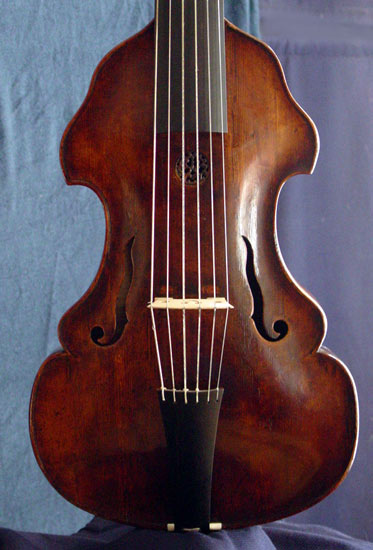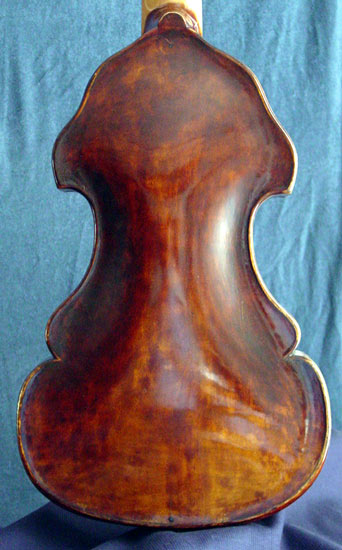 |
 |
Viola da gamba
Treble II , ca. 1730, (in leaf form)
 |
 |
One finds this very curious form in Italy, Austria, Germany, Holland and England. Nr. 80 was bought in Spain around 1980. I bought the second one in 1998 in Bonhams London, thinking that it was a twin to the first one. Many years later the dendrochronological investigations of the University of Hamburg proved that the wood from the tops of the two instruments not only were from the same time, but also from the same tree!
Dendrochronological analysis(Dendrochronology is the science of dating objects made out of wood by measuring the year rings in the wood used in the object's construction and comparing the results to data banks collected for this purpose. This methods establishes with reasonable certainty a date before which the instrument could not have been made. Most violin makers use woods which have been aged for about five to ten years.)
Bericht über die dendrochronologische Untersuchung einer
Viola da Gamba, Diskant (Zettel: Gianbattista Grancino)
Die einteilige Fichtenholzdecke enthält 302 Jahrringe. Mit der Vergleichskurve aus der Alpenregion konnten die Jahrringe zwischen 1712 und 1411 eingeordnet werden. Somit stammt der jüngste auf der Decke vorhandene Jahrring aus dem Jahre 1712.
Die Fichtenholzdecke ist von demselben Baum gearbeitet, wie die Viola da gamba, diskant (Marcel Pichler?) mit einem jüngsten Jahrring von 1729.
Somit kann bei einer minimalen Lagerzeit des Holzes von einem Jahr kann die Decke frühstens ab 1730 entstanden sein.
Prof. Dr. Peter Klein
Ordinariat für Holzbiologie
Universität Hamburg
Report on the dendrochronological analysis of a
Viola da Gamba, treble (Label: Gianbattista Grancino)
The one-part spruce front contains 302 year-rings. With the comparative curve from the Alpine regions the year-rings could be dated between 1712 and 1411. Therefore the youngest ring present on the front comes from the year 1712.
The spruce top comes from the same tree as on the Viola da gamba, treble, (Marcel Pichler?) with a youngest Year-ring of 1729.
Considering a minimal time for curing the wood of one year, the front could have been made in 1730 at the earliest.
Prof. Dr. Peter Klein
Ordinariat für Holzbiologie
Universität Hamburg
More on dendrochronology
Body length mm Upper width 204 mm Middle width 130 mm Lower width 263 mm Rib height mm String length 410 mm
updated03.10.2007